-
Posts
6258 -
Joined
-
Last visited
-
Days Won
2
Content Type
Profiles
Forums
Events
Posts posted by michel123456
-
-
And here the solution.
Diagram 1 is correct:
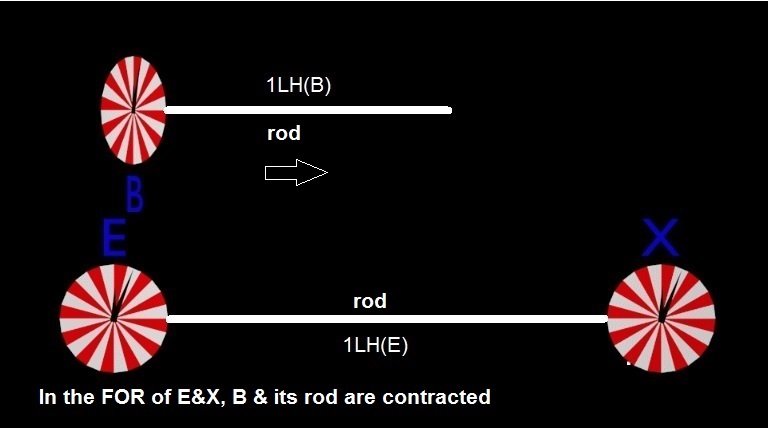 diag 1.
diag 1.
From E and X, because of its relative state of motion, B is contracted and its rod is contracted too. The effect is a scale factor along the line of motion: the units of length of B look to have be scaled by a factor of 0.6, because of the 0.8c velocity.
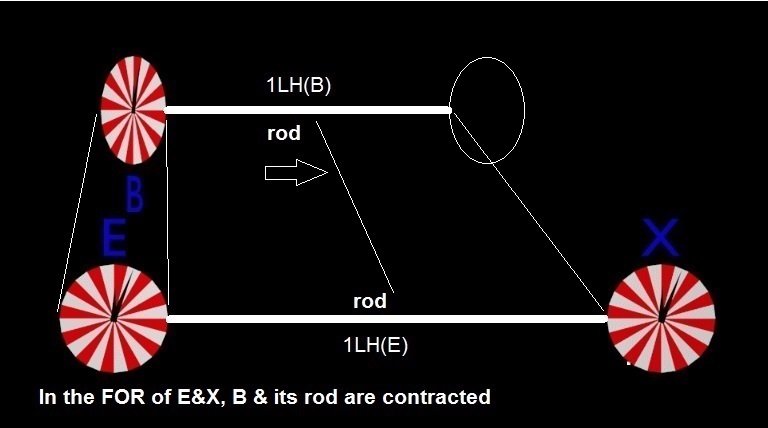 diag 1 annotated
diag 1 annotated
The diagram says that B's rod that E observes as 1 LH corresponds to 0.6 LH in the frame of E.
IOW the distance 1LH toward X (as observed in E) corresponds to 0.6 LH again in the frame of E. (and not in the frame of B)
IT DOES NOT SAY THAT THE DISTANCE IS 0.6 LH IN THE FOR OF B.
The 45 min calculated in several posts before does not correspond to anything.
In the FOR of B, the distance is still 1 LH. And to travel 1 LH, the clock on B will tick for 75 minutes.
Here below the situation from the FOR of B
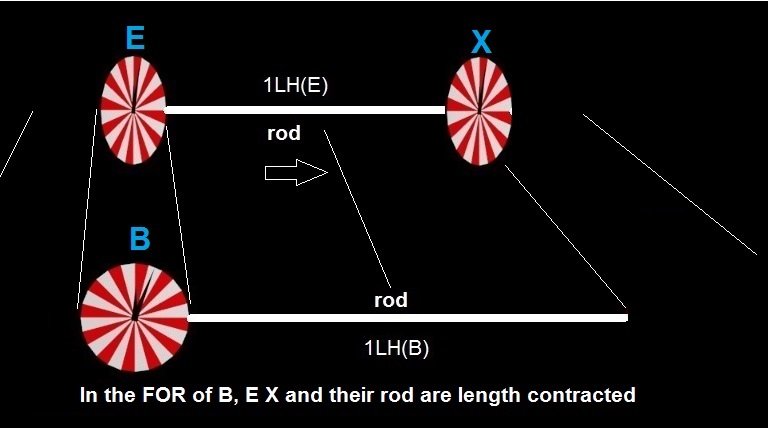 diag 10
diag 10
It corresponds exactly to diag 1. The labeling has been reversed (E for B). In both, the distance to travel is 1LH. And in both, the time to travel is 60min / 0.8 = 75 min.
0 -
12 hours ago, md65536 said:
I don't care whether you ever learn relativity. It's still interesting to find errors in what seems like paradoxes, but you're just adding complication on top of previous errors. Why not go simpler instead of more complicated? You don't have a solid foundation to build on, but you're building anyway.
I think that's wrong. How do you get that X takes 45 minutes?
If B starts at E, and the length to X is length-contracted to 0.6 LH (in B's frame), then X is already at that location (in B's frame) at B's time 0.
A problem when introducing rods like this is that you can't just compare both ends of a rod at a single time that applies in multiple frames. You have to consider relativity of simultaneity (the real one, not "what I'm calling RoS" etc). You could always label the events that you're describing, in the frames you're describing (so it's not just an x-coordinate like Xb, but an x and a time coordinate, and they're different in different frames).
But I still think you're wasting your time. I think you would do better trying to learn Galilean relativity.
Think you for being constructive. I understand that some are getting tired, but for me also it is exhausting. It is so evident to me that the paradox is wrong that it blows my mind that it has been accepted and become a mainstream element of Relativity. The paradox must be wrong, not generally Relativity. One may accept that the traveler ages differently than the one ate rest, that is not an issue. But since velocity is relative, you cannot know who is at rest and who is moving (and all attempts to evade this point are BS- Bad Science). Since you don't know who is the one in motion, and who is not, the phenomena must be symmetric: what one observes is the same as the other observes , independently of Euclidian or other geometry. If you rely on the fact that geometry is not Euclidian to resolve the paradox, then you may be very intelligent but not very at the same time (like the twin younger than his sibling), another paradox.
12 hours ago, md65536 said:22 hours ago, michel123456 said:diag 6
Exactly the same diagram with annotated the point Xb that is on the rod of B at 0.6 LH from him. X will reach this point in 45 min from the FOR of B. It is the same point Xb that is shown in diag 3.
I think that's wrong. How do you get that X takes 45 minutes?
If B starts at E, and the length to X is length-contracted to 0.6 LH (in B's frame), then X is already at that location (in B's frame) at B's time 0.
Yes X is at that location, when moving toward B, it will take 45 min* to reach B.
*the 45 min. have been calculated by others. I disagree with this.
0 -
I have read this thread again and again
On 10/15/2020 at 5:44 PM, Markus Hanke said:so I don’t think the problem is one of understanding.
However, all the answers from valuable members here are based on the assumption that I don't understand relativity.
On 10/15/2020 at 5:44 PM, Markus Hanke said:Relativity really isn’t that difficult to grasp
Exactly, it is not so difficult to grasp.
Here below some new diagrams that I hope will make you think again.
The basis has been stolen from the animations of @Janus on page 9.
Find the error:
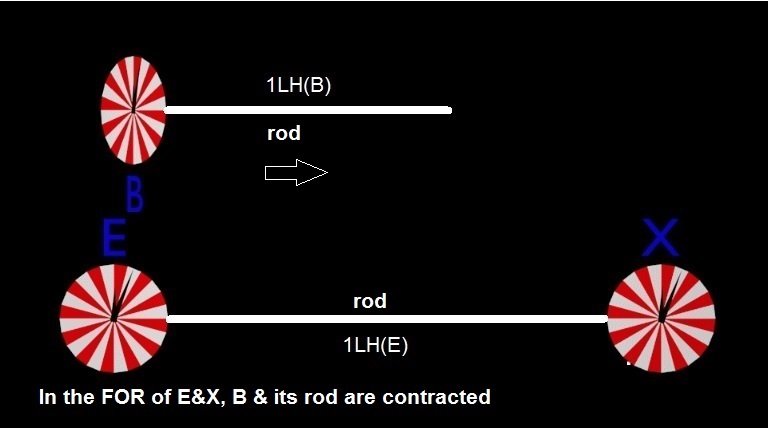 diag 1
diag 1
E and X are at rest, B is moving. I have inserted a solid rod 1LH long in order to evade the comments like "space does not move & thus do not contract"
Since B is moving together with its rod, both are time dilated & space contracted. The rod of B is 1LH long in the frame of B (see below diag 4).
The notation 1LH(B) means 1 Light Hour from the FOR of B.
diag 2
Exactly the same diagram, with the position of 0,6LH which is the contraction of B's rod from the FOR of Earth and planet X
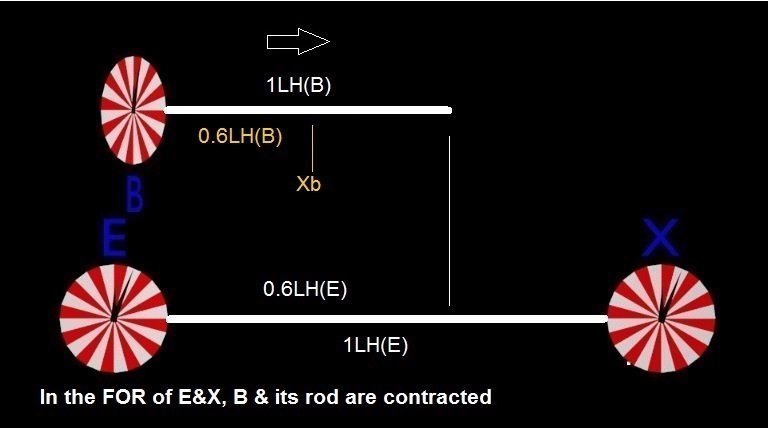 diag 3
diag 3
Exactly the same diagram with the position of 0,6LH in the rod of B (from the FOR of E & X). I have labeled the point as Xb, that is 0,6LH from B.
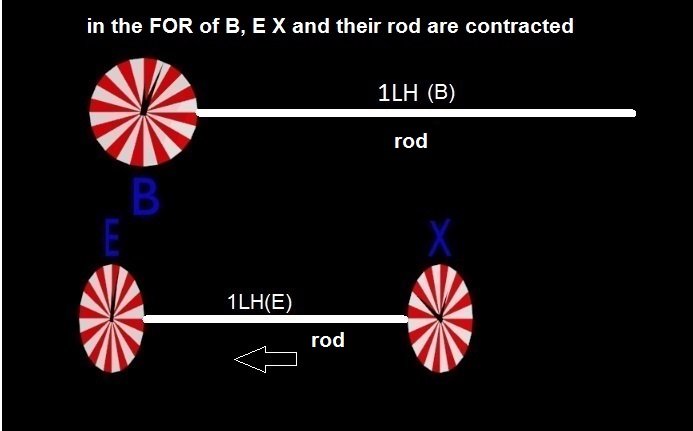 diag 4
diag 4
Now the things as from the FOR of B: E and X are moving together with their rod, thus they are time dilated & length contracted.
diag 5.
Exactly the same diagram with annotated the 0,6 LH traveled by E & X.
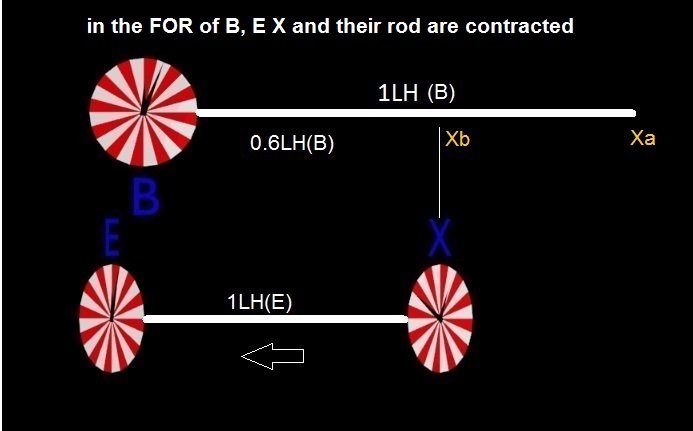 diag 6
diag 6
Exactly the same diagram with annotated the point Xb that is on the rod of B at 0.6 LH from him. X will reach this point in 45 min from the FOR of B. It is the same point Xb that is shown in diag 3.
Xa is the label for the point at the end of the rod of B
AND NOW THE QUESTION:
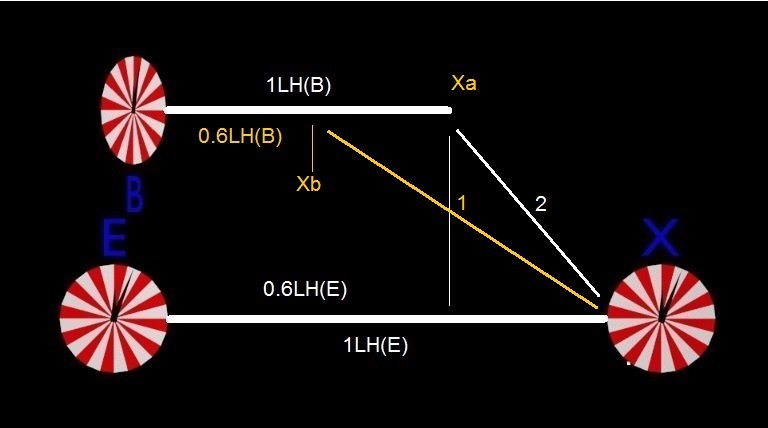 diag 7
diag 7
Return to Earth and planet X FOR. Where is the correct contraction?
Is it along diagonal 1 or along diagonal 2?
We can check out:
Here with diagonal 1, the upper part has been stretched along the direction of movement in order to make correspond point Xb and planet X (because that is the result of calculations that say the travel of B will last 45 min in the FOR of B)
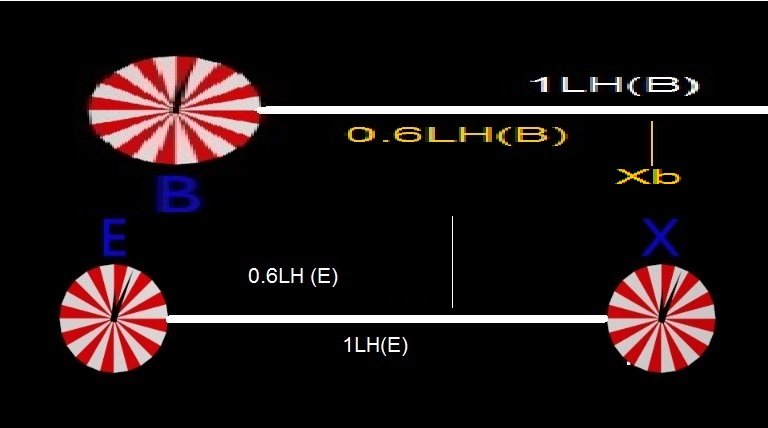 diag 8
diag 8
And here below with diagonal 2.
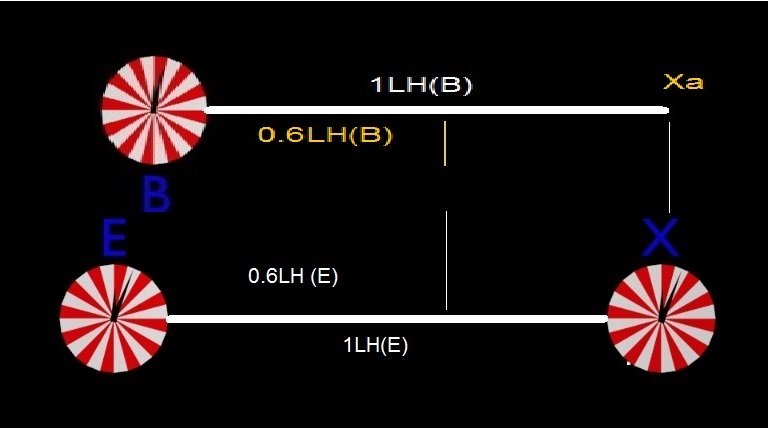 diag 9
diag 9
Which one is the correct one, where is the error?
0 -
13 hours ago, md65536 said:
I see. That kind of makes sense... B measures a shorter trip but a delayed start and ends up with the same time that X has.
That's not special relativity. There's no point in discussing what special relativity predicts any further, if we're talking SR while you're talking about your own ideas in the language of SR. I could demonstrate why "when B starts moving relative to X, X is delayed before moving relative to B" is inconsistent, but if you have no problem picking aspects of relativity that you like while rejecting others, you'll continue finding ways to make the numbers add up to whatever you want, with no regard for consistency.
You won't understand relativity while ignoring what it predicts. I don't think that's a problem, and I don't think you do either. Not everyone needs to understand it. Sorry it didn't work out.
But when @Eise quoted @Janus & explained the "However" part, that made sense to you, and it was about Relativity.
As a reminder:
On 10/3/2020 at 9:48 PM, Janus said:B is at rest while the Earth and planet X move to the left at 0.8c.
the Earth, planet X, their clocks, and the distance between them is length contracted. B is not.
It take 45 min by B's clock for planet X to travel from being 0.6 lh away to B at 0.8c
Earth and planet X's clocks are time dilated and only accumulate 27 min during this time.
However, due to Relativity of Simultaneity, the Planet X clock already reads 48 min later than Earth's clock when B and the Earth are next to each other. Thus the 27 minutes it advances brings it to 1 hr 15 min, as it passes B. The times on Earth's clock and B's clock when they are next to each other agree with the first animation, and the Times shown on B's clock and Planet X's clock when they are next to each other also agree with the first animation.
13 hours ago, md65536 said:I see. That kind of makes sense... B measures a shorter trip but a delayed start and ends up with the same time that X has.
Yes. B measures 75 min.
Not 45 min.
And there is no paradox.
0 -
1 hour ago, md65536 said:
Bold emphasis mine:
That's your statement, it's about two clocks.
I can't imagine how to explain why this is wrong if you don't understand that you're talking about different clocks. Are you purposefully making statements that you know are nonsense? (A strawman to defeat) Or do you think your statement makes sense and is true?
I believe that in the FOR of B, X does not start to move instantaneously.
0 -
16 hours ago, md65536 said:On 10/12/2020 at 1:02 PM, michel123456 said:
Taking from your statements, reversed, that should give:
45+?=75 says "The amount of time that B's clock ticks while B travels, plus the time on B's clock when X begins equals the time on X's clock then B arrives."
And we can assume that the result should be:
?=30min.
But that's incorrect. Times on B's clock don't add up to times on X's clock.
Do you at least understand that you're talking about 2 different clocks? I know it's only page 12 but do you understand that much so far?
You should read again the statement. It is about B's clock.
It states that you must add to B's clock the RoS caused by the fact that E and X are not experienced in simultaneity by B.
0 -
On 10/11/2020 at 7:37 AM, md65536 said:
45+?=75 says "The amount of time that B's clock ticks while B travels, plus ??? equals the time on X's clock then B arrives." That doesn't make sense, because those times are measured by different clocks.
Taking from your statements, reversed, that should give:
45+?=75 says "The amount of time that B's clock ticks while B travels, plus the time on B's clock when X begins equals the time on X's clock then B arrives."
And we can assume that the result should be:
?=30min.
0 -
8 hours ago, Eise said:
Yes. But that is not the time that B sees, it is what B concludes, given the signal delay. Just take care that you do not mix up what observers see, and what they can conclude about what really is going on. Your 'show' is ambiguous.
Thanks.
Other question, on the grounds of what has been explained previously.
I understand that there are at least 3 stages of calculations:
Stage 1, Earth & Planet X are at rest, B is moving, contracted & time delayed : you insert the opening statements (1LH of distance, velocity 0.8c) and extract the result= Time of travel 75 min. in the FOR of E & X
Stage 2, B is at rest, Earth & Planet X are moving: the distance between E & X is contracted by a factor of 0.6, so the distance becomes 0.6LH & velocity 0.8c give Time of travel 45 min. in the FOR of B
Stage 3, B is at rest again, (quoting from Janus)
“B is at rest while the Earth and planet X move to the left at 0.8c.
the Earth, planet X, their clocks, and the distance between them is length contracted. B is not.
It take 45 min by B's clock for planet X to travel from being 0.6 lh away to B at 0.8c
Earth and planet X's clocks are time dilated and only accumulate 27 min during this time.
However, due to Relativity of Simultaneity, the Planet X clock already reads 48 min later than Earth's clock when B and the Earth are next to each other. Thus the 27 minutes it advances brings it to 1 hr 15 min, as it passes B. The times on Earth's clock and B's clock when they are next to each other agree with the first animation, and the Times shown on B's clock and Planet X's clock when they are next to each other also agree with the first animation.”
I have put these 3 stages in this sketch below: (this is not a spacetime diagram, simply a sketch that puts my ideas all together)
Relativity of Simultaneity (RoS) is used in stage 3 in such a way that after the calculation pirouette, everything comes back in place: stage 3 corresponds to stage 1 with 75 min. recorded Time of Travel.
That is fine.
My questions are thus the followings,
1. why is there no use of RoS in stage 2? (the question mark on the sketch)
2.I am confused about the calculation procedure generally: why does it go one way (here from up to down) instead of going forth & back?
0 -
4 hours ago, Eise said:
Janus explained that here. If you do not understand his explanation, why did't you simply ask?
As Janus already said, when two clocks on different locations are synchronous in their common FOR, then they are not synchronised in a FOR moving relative to the first. But this was already said to you.
I just used the Lorentz transformations, i.e. the coordinate transformations between 2 FORs. Do not forget: B is already moving with 0.8c. As you see from my calculation example, t also depends on x', not just on t' alone. I hope you know what the Lorentz transformations are, if not, look them up in Wikipedia.
I am sorry. I am continuously messing the FOR's.
B is at rest. Earth & X are moving. B is calculating with Lorentz transform what clocks on Earth & X are showing. At 12:00 the travel begins (that's the only thing I understand so far!!). By your calculations you say that when the departure bell rings at 12:00, clock on X shows 12:48. (according to B). Is that it?
0 -
On 10/3/2020 at 9:48 PM, Janus said:
B is at rest while the Earth and planet X move to the left at 0.8c.
the Earth, planet X, their clocks, and the distance between them is length contracted. B is not.
It take 45 min by B's clock for planet X to travel from being 0.6 lh away to B at 0.8c
Earth and planet X's clocks are time dilated and only accumulate 27 min during this time.
However, due to Relativity of Simultaneity, the Planet X clock already reads 48 min later than Earth's clock when B and the Earth are next to each other. Thus the 27 minutes it advances brings it to 1 hr 15 min, as it passes B. The times on Earth's clock and B's clock when they are next to each other agree with the first animation, and the Times shown on B's clock and Planet X's clock when they are next to each other also agree with the first animation.
@Eise here above. What is "Relativity of Simultaneity"? And what are the 48min that Planet X clock already reads when B and the Earth are next to each other ?
0 -
1 hour ago, Eise said:
Well, if you just show '60 min x 0.6 = 36 min' it is not clear to me how you got to these values. (60 min and 0.6). Which formula did you use?
Time dilation factor is 0.6
Janus calculated 1h & 15 min dilated into 45 min. That is 75min x 0.6= 45 min.
Lenght contraction factor is 0.6: the 1LH distance contracted into 0.6 LH
So I expected that the time lag 1 hour (the delay) would become 60min. x 0.6 = 36 min. (the time light need to travel 0,6 LH).
0 -
8 hours ago, Janus said:
The distance between c and E and The distance between c and X are the same. So are you claiming that an observer at c will say an object going from E to X ( along the red arrow) traveled zero distance? Of course not. The same holds for an observer at d, or e, f and g. They all would say that an object moving from E to B traveled the same distance in the same time. It doesn't matter how far you put your observer away, the traveled distance doesn't converge to 0, but remains the same.
Velocity is a vector:
from wiki
QuoteVelocity is a physical vector quantity; both magnitude and direction are needed to define it. The scalar absolute value (magnitude) of velocity is called speed, being a coherent derived unit whose quantity is measured in the SI (metric system) as metres per second (m/s) or as the SI base unit of (m⋅s−1). For example, "5 metres per second" is a scalar, whereas "5 metres per second east" is a vector. If there is a change in speed, direction or both, then the object has a changing velocity and is said to be undergoing an acceleration.
For E, velocity is speed 0.8c going out. The input, for him, is Vout=0,8c
for X, velocity is speed 0.8c going in. The input for him, is Vin=-0.8c
The direction of Vin is opposite to the direction of Vout: it is a different vector, so it must be understood as a different velocity.
Which one is the correct for observer g? Vin or Vout?
Which one is the "good one"?
-------------------------
And
13 hours ago, michel123456 said:21 hours ago, Eise said:Of course you can. Subtract the effect of the signal delay, and you should get the relativistic time dilation. But I am not so versed in such calculations anymore.
OK, it really was so simple:
Take the inverse Lorentz transformation for time (we are looking at how B sees X at the moment of passing Earth, not how Earth sees B's time):
Whereby gamma:
We take t = 0 for ease, so in our example we get:
vx'/gamma =(0.8 x 0.6)/0.6 = 0.8.
1 Lh = 60 LMinutes, so 0.8 x 60 LMinutes makes 48 minutes.
Now back to my databases...
I expected a result like 60 min x 0.6 = 36 min.
I expected my calculation to be corrected by someone. (the one in the bottom that gives 36 min.)
0 -
7 hours ago, Eise said:
Of course you can. Subtract the effect of the signal delay, and you should get the relativistic time dilation. But I am not so versed in such calculations anymore.
OK, it really was so simple:
Take the inverse Lorentz transformation for time (we are looking at how B sees X at the moment of passing Earth, not how Earth sees B's time):
Whereby gamma:
We take t = 0 for ease, so in our example we get:
vx'/gamma =(0.8 x 0.6)/0.6 = 0.8.
1 Lh = 60 LMinutes, so 0.8 x 60 LMinutes makes 48 minutes.
Now back to my databases...
I expected a result like 60 min x 0.6 = 36 min.
1 hour ago, Janus said:No, the geometry does not evidently show the relative velocity as be almost null. As the observer gets further away, the angular velocity he would measure would decrease, But since the actual relative velocity is w x d*, Where w is the observed angular velocity and d is the distance to b, the increase in d cancels out the decrease in w and gives a constant answer for the relative velocity no matter how far the distance d is.
Also, the distance between E and X doesn't change with an increase of d, and the fact that the E- observer distance and the X-observer distance is the same, just makes its easier for the observer to determine that B traveled at 0.8c . For example, lets assume that the observer is 1000 ly away from both. B leaves E, and the light of this event heads off towards our observer, it takes 1000 yrs to reach him. It takes 1 1/4 hours for B to reach X, so 1 1/4 hr after the light of B leaving E is emitted, the light of B arriving at X is emitted. It also takes 1000 yrs to reach the observer. This means that the light telling the observer that B arrived at X arrives 1 1/4 hrs after the light telling the observer that B arrived at X. Since the observer knows that he is an equal distance from both, he know that the light from these events took equal times to reach him, so he knows that the 1 1/4 difference between his seeing these event is exactly the same as the time it actually took B to go from E to X. The distance between E and X is 1 light hour, so he knows be traveled at 0.8 relative to them, and since he is at rest with respect to them, 0.8c relative to himself.
This is all pretty straight forward, and in no way supports your conclusion.
* technically, this equation assumes that B is traveling along an arc of a circle with our observer at the center. B is actually traveling a straight line. This would have the effect of causing the measured angular velocity to change as B went from E to X. Starting at a one value, increasing to a maximum at the midpoint, then decreasing again. This variance in angular speed would be largest with small values of D and decrease ( but never totally vanish) at larger values of D. If we assume D is very large, we can safely ignore this without too much loss of accuracy.) While complicates things a bit, it does not change the fact that our observer will always get a value of 0.8c for the velocity of B
Pretty straight forward yes, except the bold part. I am naive to believe that velocity is measured by δ distance divided by δ time. Since distance between the observer & the traveling clock remains the same (between the observer & the traveling object), δ distance is zero. So relative velocity (between the observer & the traveling clock) is zero. And the observer should see no time dilation & no length contraction (in relation to him). Although the same observer will see (according to what everybody say here) exactly what diagram 1 shows: a clock traveling 1LH in 1h:15 and ticking only 45 minutes, contracted sideways.
0 -
6 hours ago, Eise said:
Of course you can. Subtract the effect of the signal delay, and you should get the relativistic time dilation. But I am not so versed in such calculations anymore.
OK, it really was so simple:
Take the inverse Lorentz transformation for time (we are looking at how B sees X at the moment of passing Earth, not how Earth sees B's time):
Whereby gamma:
We take t = 0 for ease, so in our example we get:
vx'/gamma =(0.8 x 0.6)/0.6 = 0.8.
1 Lh = 60 LMinutes, so 0.8 x 60 LMinutes makes 48 minutes.
Now back to my databases...
gamma is 1.66666 in our example.
1/gamma is 0.6
0 -
40 minutes ago, Eise said:2 hours ago, michel123456 said:
What is about the formula above? Is it about what someone sees, or about what actually happens?
That is the formula for the Doppler effect for light. So it is about what you see. And this formula is only valid if the movement of sender and receiver is along the same line as the straight line between source and receiver. So here you have definitely dependency on the direction of the movement.
I was just asking because from this formula was extracted what is happening (according to all other members here).
0 -
On 9/19/2020 at 6:52 PM, michel123456 said:
What is about the formula above? Is it about what someone sees, or about what actually happens?
On 10/3/2020 at 9:48 PM, Janus said:If we now consider things from B's inertial frame of reference, you get this.
B is at rest while the Earth and planet X move to the left at 0.8c.
the Earth, planet X, their clocks, and the distance between them is length contracted. B is not.
It take 45 min by B's clock for planet X to travel from being 0.6 lh away to B at 0.8c
Earth and planet X's clocks are time dilated and only accumulate 27 min during this time.
However, due to Relativity of Simultaneity, the Planet X clock already reads 48 min later than Earth's clock when B and the Earth are next to each other. Thus the 27 minutes it advances brings it to 1 hr 15 min, as it passes B. The times on Earth's clock and B's clock when they are next to each other agree with the first animation, and the Times shown on B's clock and Planet X's clock when they are next to each other also agree with the first animation.
Again: Please explain the bold part:
Please correct me: the planet X clock stays in X's FOR. Which means (by me) that X clock reads 13.00 when B passes next to E (for clock X, the distance is not contracted). Where do the 48 min. come from?
0 -
3 minutes ago, Janus said:
I don't think you understand what "frame of reference" means in Relativity. It is not the same as a "point" of reference. A frame of reference includes all points regardless of their relative position that are at rest with respect to each other. So as long as Earth and X are motionless with respect to each other, they share the same frame of reference, and there is not an "Earth frame of reference" and a "Planet X frame of reference", but a single reference frame which Earth and Planet X are at rest with respect to. And in that reference frame, the Earth and Planet X clocks are synchronized. The fact that different observers placed at different positions in that reference frame would visually see different times on those clocks does not change the fact that all these observers would agree that these clocks are "in fact" synchronized with each other.
Differences in position has no effect on the determination of simultaneity, only differences in velocity.
So you are saying that the 1h delay between Earth & X does not count for relativity?
0 -
So i have to rephrase my question:
In animation 1 the clocks are synchronized and show the same time. If they show the same time, it means that it cannot be the situation in the FOR of the Earth. it is not the situation in the FOR of X either (there is an hour of difference: for the Earth departure time is 12.00 & it is 11.00 on X, for X departure time is 13.00 & it is 12.00 on Earth). The animation does not show the 2h15min that were needed for Earth to receive the signal of the arrival at X. IOW animation 1 is that of a virtual observer.
Animation 2 has a different concept: it is from the FOR of B.
So the question is; why is animation 2 not from a virtual observer? that would show the clocks synchronized I suppose, like animation 1.
7 hours ago, Eise said:It looks very much like "Damn't, I cannot argue against that, so let's go to another point. These explanations must be wrong, so let's try another argument".
Sorry, I have to digest the answers.
7 hours ago, Eise said:This seems typical for the way how you cope with relativity, or better, with the reactions you get. After you got 2 reactions that also the 'virtual observer' measures a velocity of 0.8c for the traveling B, you do not react anymore on it. I would expect an 'ah, now I understand', or another argument why the velocity would not be 0.8c.
Yes i am baffled. To me, geometry shows evidently that the relative velocity is almost null since it is perpendicular to the line of sight. The fact that the virtual observer is in the same FOR of earth & planet X has nothing to do with that. Geometry still counts.
0 -
On 10/3/2020 at 9:48 PM, Janus said:
B is at rest while the Earth and planet X move to the left at 0.8c.
the Earth, planet X, their clocks, and the distance between them is length contracted. B is not.
It take 45 min by B's clock for planet X to travel from being 0.6 lh away to B at 0.8c
Earth and planet X's clocks are time dilated and only accumulate 27 min during this time.
Why are the clocks E and X not synchronized?
0 -
-
11 hours ago, swansont said:
B is moving essentially tangent to the observer. The radial velocity is zero. The tangential velocity is not.
Let's admit that there is a resultant velocity. Is this velocity equal to 0.8c?
0 -
1 hour ago, Eise said:2 hours ago, michel123456 said:
You have evaded the question: what is the speed of B in the FOR of the virtual observer?
I already answered that:
3 hours ago, Eise said:The speed of B in the FOR of E and X is 0.8c
And the observer is in the same FOR as E and X. Don't you see that E and X are standing still in Janus' first animation? That means the virtual observer is in the same FOR as E and X.
Do you say that the speed of B related to Virtual Observer is 0.8c?
But the distance between B and V.O. do not change. How do you explain that?
0 -
23 minutes ago, swansont said:31 minutes ago, michel123456 said:
And what is the speed of B in the FOR of the virtual observer?
The observer is at rest wrt E and X, so it’s in the same frame. All of the measured values will be the same.
You have evaded the question: what is the speed of B in the FOR of the virtual observer?
0 -
39 minutes ago, Eise said:
No again. B is not in the same frame of reference as Earth, X and the 'virtual observer'. These 3 are in the same FOR. B is not.
With other words, this your problem 1:
So to extend on Swansont's reaction above:
In the FOR of E and X (and the observer):
- B travels a distance of 1Lh
- It takes B 1:15h to get from E to X.
In the FOR of B:
- B travels a distance of 0.6c
- It takes him 45 minutes
No, this is physically perfectly possible. Imagine the observer at my spacestation (see above, it stands still in the FOR of E, and X)), making a movie of what happens. Janus' animation shows exactly what the clocks will look like.
Yes, both. The speed of B in the FOR of E and X is 0.8c. I think you have here problem 2: relativity has nothing to do with delay of signals. In what you really observe delay plays a role. But not in what actually happens. When relativity would be based on signal delays, your argument would make sense. But relativity is not based on signal delay. It does not describe what you see, but what actually happens. So:
And what is the speed of B in the FOR of the virtual observer?
0



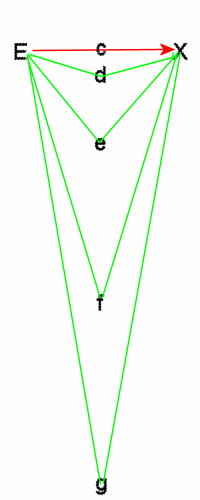



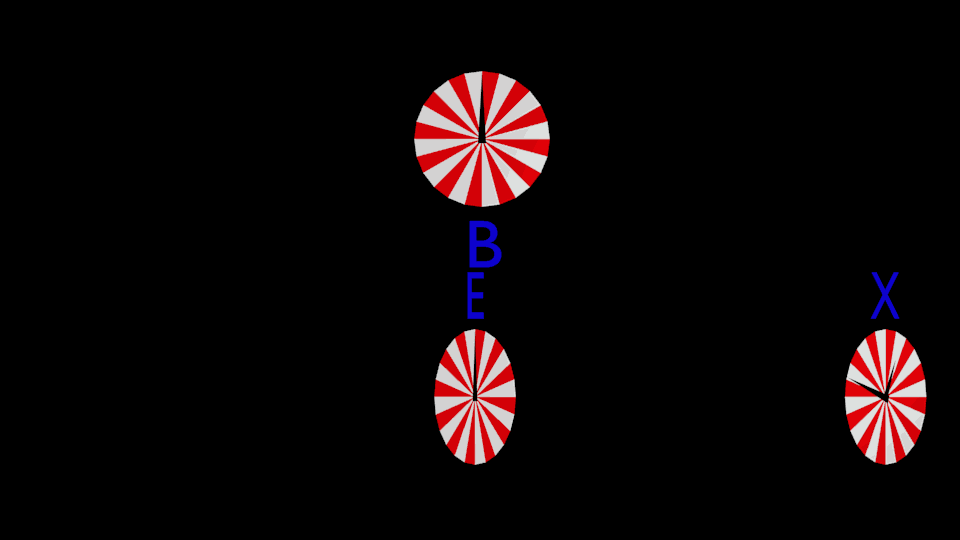
Gravity
in Classical Physics
Posted
No. It was shown by Galileo Galilei in 1638.
When you scale down (or scale up) you must take account of the square-cube law. https://en.wikipedia.org/wiki/Square–cube_law